Getting Started
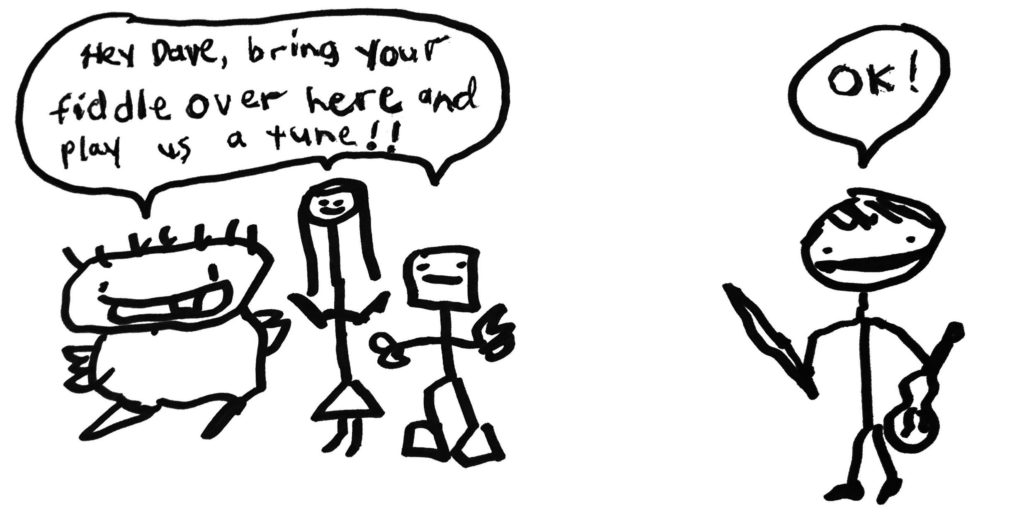
Welcome to FiddleHed 👋
It’s good to have you here! On this page I’ll help you understand the course so that you can achieve your fiddle goals and dreams. You’ll find things to help you on the journey in the tabs below.
Need a violin?

Click here and I’ll help you to get one.
FiddleHed Site Tour
Here’s a video tutorial to help you navigate the site. I’ll talk through the main elements of the home page as well as the menus.
Self-Assessment
How Self-Assessment Works
FiddleHed is a self-paced course for beginner, intermediate and advanced students. While that’s awesome, it can also be overwhelming. Especially if you’ve played before and don’t want to start at the very beginning.
Below you’ll find a self-assessment tool. I explain it in this 5-minute video. But here’s the process in a nutshell.
- Read through the lesson content for each level in the tabs below.
- Find a module and start learning. Best to err on the side of more beginner lessons.
- If it’s too easy skip ahead. If too hard, then rewind.
- Be sure to take all the lessons in the “Essential Learning Strategies” (find these in the last tab on this page). No matter what level you’re at, I think you can benefit from these innovative practice techniques.
How to Assess Your Skill Level
Here’s a video to explain the self-assessment process:
Here’s a sketch which maps different skill levels to specific modules in the course:

The sections below go into more detail on what you’ll learn in the modules.
Absolute Beginner: Modules 1.1 - 1.5
In modules 1.1 to 1.5, you learn the essentials of posture, plucking, bowing, fingering and scales along with specific tunes to practice each skill.
Skills: basic posture, plucking, bowing and fingering. Key tune: Twinkle, Twinkle Little Star.
Skills: tuning aids, fiddle tabs, and the “Little Lift” technique. Key tune: Freres Jacques.
1.3 One Small Giant Step for Mankind: The D Major Scale
Skills: A-string notes, and D Major call-and-response. Key tune: Oh Susannah.
1.4 More Scales, More Tunes, More Fun, More or Less
Skills: G-string notes, G Major scale, and staccato bowing. Key tune: Kerry Polka.
Skills: E-string notes, A Major scale, and tone-building. Key tune: Blackest Crow.
🎯 If one of these modules feels right for you, then click through to the module page to explore further.
⬇️ If that all seems too easy then take a look at the Advanced Beginner level lessons below.
Advanced Beginner: Modules 1.6 - 1.10
In modules 1.6 to 1.10, you’ll fine-tune your ear and dexterity with advanced techniques, scales, and tunes to elevate your playing skills.
1.6 Living in the Ear Now
Skills: smooth bowing with slurs, rhythmic scale variations, coordination with pedal patterns, interval exercises, and ear training. Key tune: “Bile ’em Cabbage Down – Variation 1.”
1.7 The Power of the Low Second Finger
Skills: mastering the Low Second Finger, exploring D and A Dorian Scales, and the Slur Three bowing pattern. Key tune: “Shady Grove.”
1.8 The High Road and the Low Road
Skills: upper octave of the G Major Scale, learning the C Major Scale, the Slur 4 bowing pattern, and transitioning between second finger positions. Key tune: Old Joe Clarke – Basic Version.
1.9 Trying Triads
Skills: understanding triads, Slur Two-Separate Two bowing, switching between bowing and plucking, and bow lifting techniques. Key tune: Tobin’s Jig.
1.10 The Way of Fiddling
Skills: applying Slur two-separate two bowing in tunes, mastering the G Major Scale over two octaves, practicing chaining, and retaining tunes through Practice Loops. Key tune: Arkansas Traveller.
🎯 If one of these modules feels right for you, then click through to the module page to explore further.
⬇️ If that all seems too easy then take a look at the Intermediate level lessons below.
Intermediate: Modules 2.1 - 2.4
In modules 2.1 to 2.4, you learn pinky finger, double stops, chords and strategies to enrich your practice.
2.1 In The Pink
Skills: mastering the Fourth Finger (pinky), transposing tunes, and the Separate One-Slur Three bowing pattern. Key tune: Hobart’s Transformation.
2.2 Look Both Ways Before You Cross
Skills: fingering and string crossing, slurring across strings, bow bouncing, and fourth finger on the A string. Key tune: Harvest Home.
2.3 Double Down
Skills: playing double stops, advanced fourth finger exercises, audiation, and complex fingering and string crossing patterns. Key tune: Saint Anne’s Reel.
2.4 Gotta Love the Low First
Skills: mastering the Low First Finger, learning the F Major scale, transposing tunes to F Major, and one-chord backup practice. Key tune: Southwind.
🎯 Do these modules speak to your current skill level? Click through to the module page for an immersive learning experience.
⬇️ If you’re looking for more of a challenge, the Advanced Intermediate level lessons await your discovery.
Advanced Intermediate: Modules 2.5 - 2.9
In the Advanced Beginner modules 2.5 to 2.9, your fiddling journey deepens with a focus on enhancing fingering techniques for double stops, exploring major pentatonic scales, and mastering chord progressions for jam sessions.
Skills: Fingering for upper string double stops, in-depth Major Pentatonic Scales, coordination in string crossing and fingering, chord progression mastery, and transposition to B Flat Major. Key tune: Soldier’s Joy – Intermediate.
Skills: Low Fourth Finger technique, upper octave B Flat Major Scale, transposing known tunes to new scales, playing chord backup, and Slur 8 bowing practice. Key tune: Lucy Farr’s.
Skills: Droning Double Stops Scale, adding double stops to familiar tunes, enhanced coordination with string crossing and fingering, and minor triad practices. Key tune: Rights of Man.
Skills: Raised third finger techniques, lower octave A Major scale, E, F, and B Flat Major chords, advanced fingering and string crossing with D Dorian notes. Key tune: Ashokan Farewell.
Skills: Chromatic scale proficiency, syncopated rhythm practice, chord building, and integration of fourth finger double stops. Key tune: Coleraine
🎯 If these modules strike a chord with you, follow the links to dive into the lessons.
⬇️ Ready for more of a challenge? Check out the Advanced level lessons that follow.
Advanced Courses
If you’ve mastered all the skills and core tunes from the Beginner and Intermediate courses, you might be ready for more advanced courses.
In the Irish Fiddle Journeys course, you will learn classic Irish ornamentation, like rolls and melodic variation.
Old-Time & Appalachian Fiddle Course
Explore Old-Time tunes, adding variation, pulse bowing and sawmill tuning.
You’ll learn new scales, bowing techniques and practice strategies which will help you to add variation to tunes. You’ll also learn things that prepare you for improvisation, playing chords and more.
If you haven’t yet learned to read sheet music, this would be a good time to dive in. Though it’s not necessary to play fiddle, reading will accelerate your learning.
Note: the note-reading lessons are also sequenced throughout the Beginner and Intermediate courses.
High-level Roadmaps
Roadmaps
Here’s a high-level view of what’s in each course:

FiddleHed course breakdown
Below is a map of the course structure.
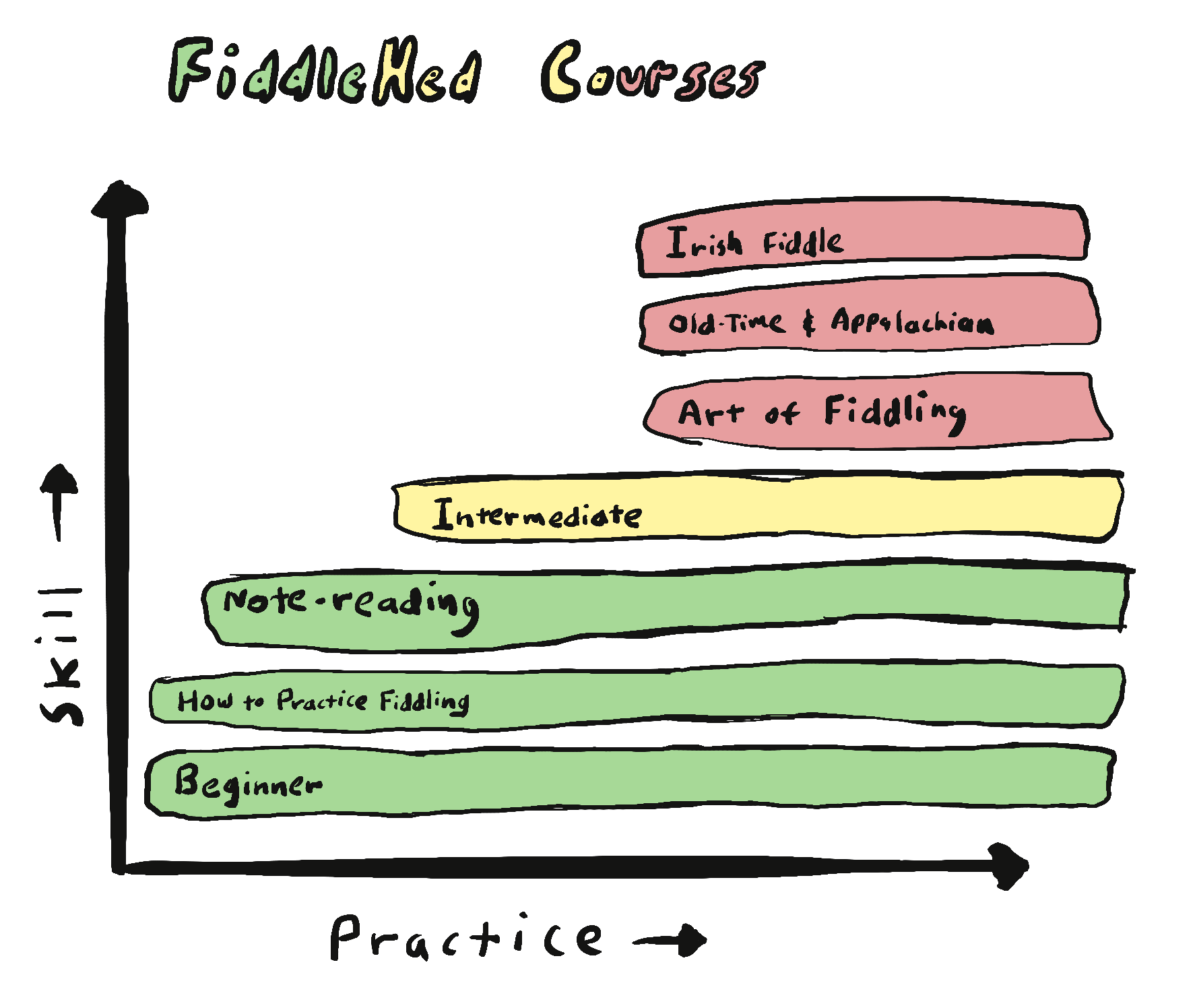
Notice in the diagram above that the “beginner” courses (green boxes) continue to run along the “practice” axis. That’s because you constantly return to FUNdamental skills like bowing, fingering, intonation, etc. as you progress.
In this video I’ll explain how the courses are structured and connected. I also talk about this in the text below.
The first two courses are part of the “Main Course”: Beginner (Modules 1.1-1.10) and Intermediate (Modules 2.1-2.9).
If you go to the main menus and hover each of those you can see individual modules within each.

Most people find success by picking a starting point and working forward from there.
There are two advanced courses on Irish and Old-time Fiddling.
There are a series of “mini-courses” which support you at any stage of the journey:
- How To Practice Music
- How To Play In Tune
- How To Play In Time
- Note-Reading For Fiddlers
- Art of Fiddling
I hope that sheds a little light on what we’re doing here. Still got questions on how courses work? If so, just email us.
Using FiddleHed
Here are tutorials to help you make the most of FiddleHed while you’re here.
Tracking Your Progress
Track progress
You can track your progress by clicking the “Start Lesson” button at the top of lesson pages.
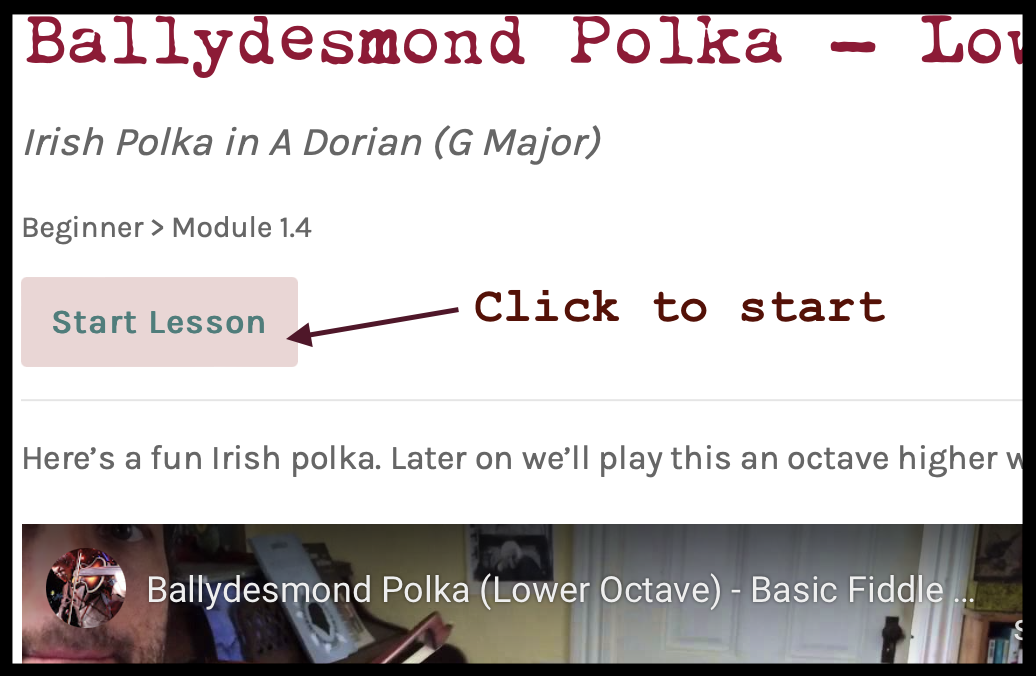
Next, you’ll see a yellow “Complete Lesson” button. Click that when you’ve finished with it. (Remember, it doesn’t have to be perfect. You can return to it later):
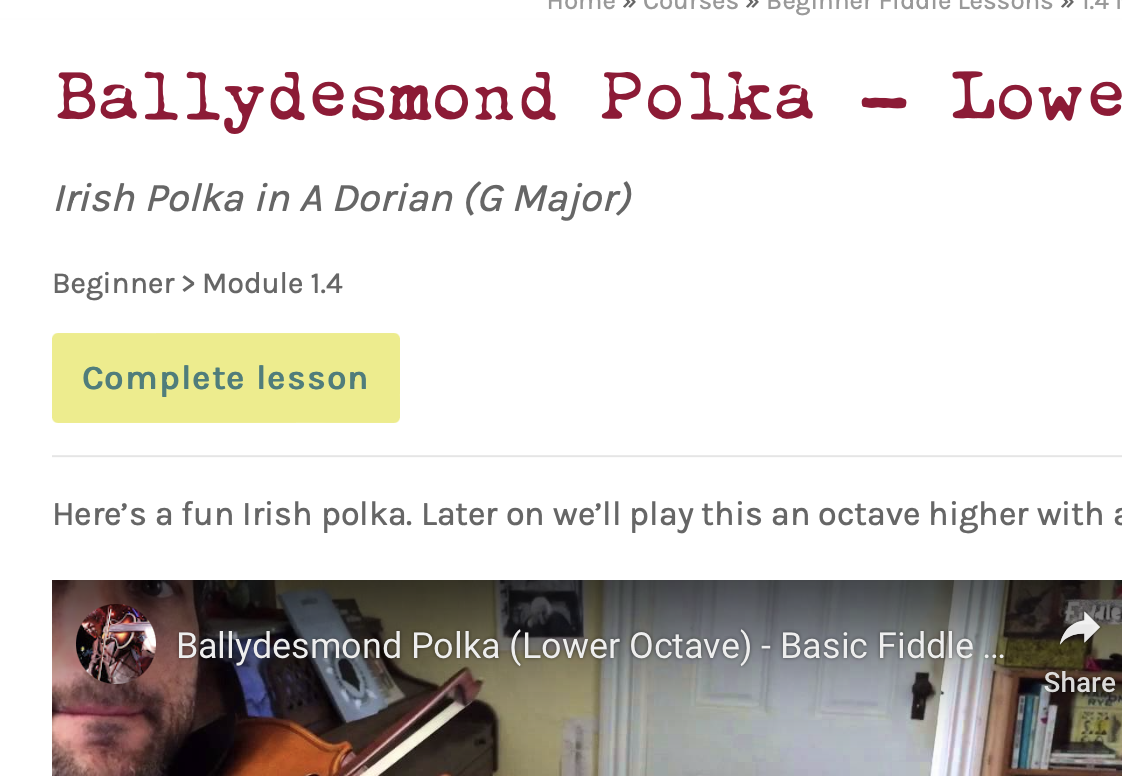
When you’re done with the lesson, click it again to complete it:
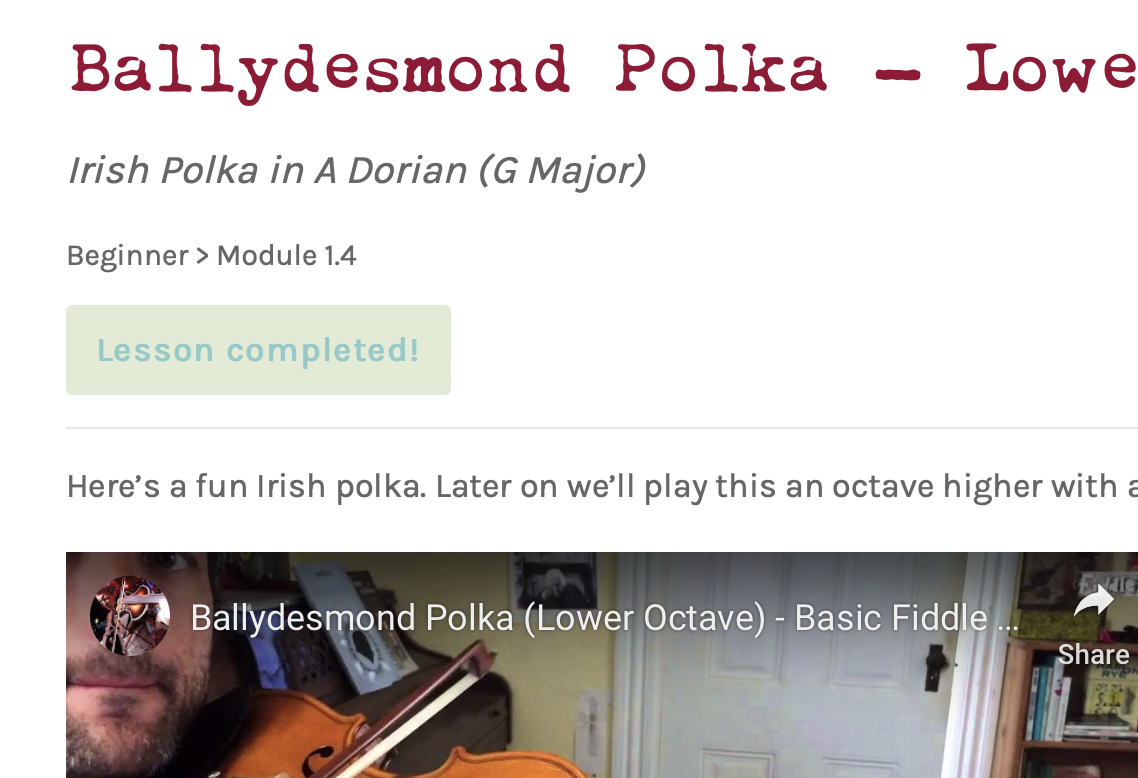
Video tutorial
See your progress
See your progress for each module page on its home page. Here’s an image from the middle of Module 1.4.
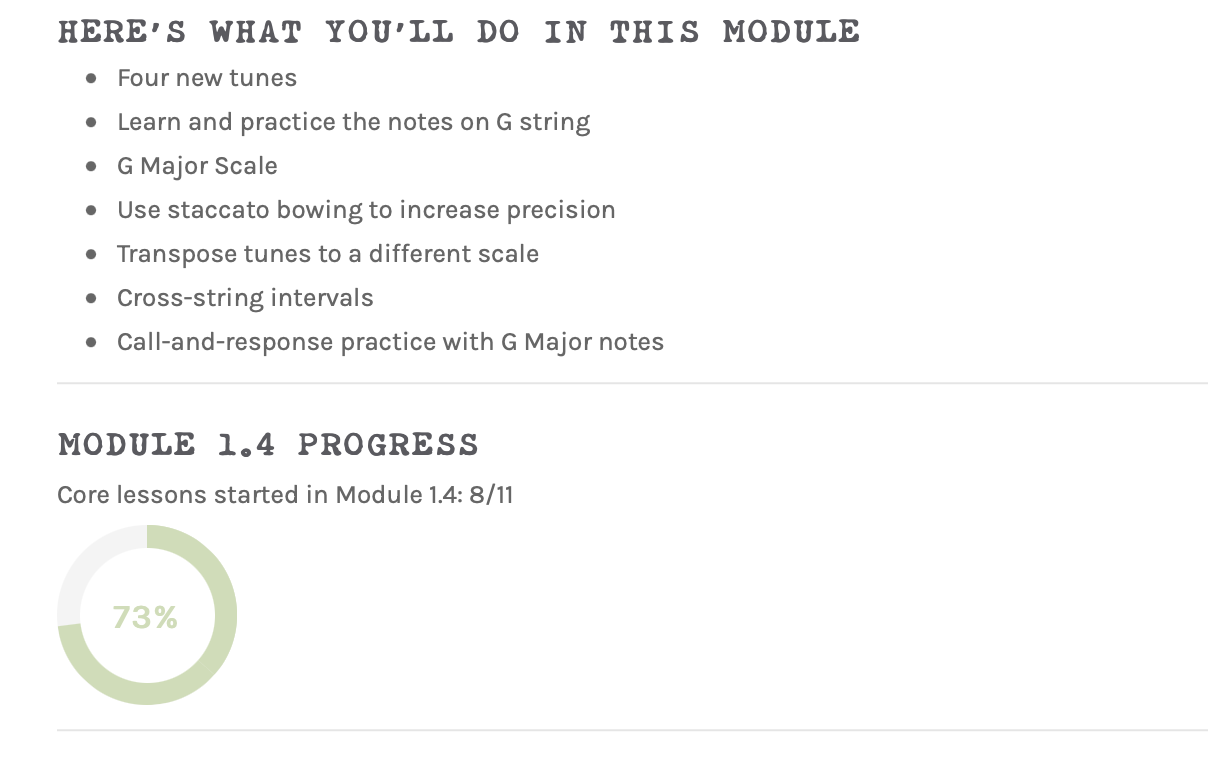
Finally, look at the “Your Course Progress” tab in the “Practice Toolkit” at the bottom of any lesson page. There you can see the last lesson started, last twenty lessons started, and total lessons started (organized by module). This is also visible on the Home Page.
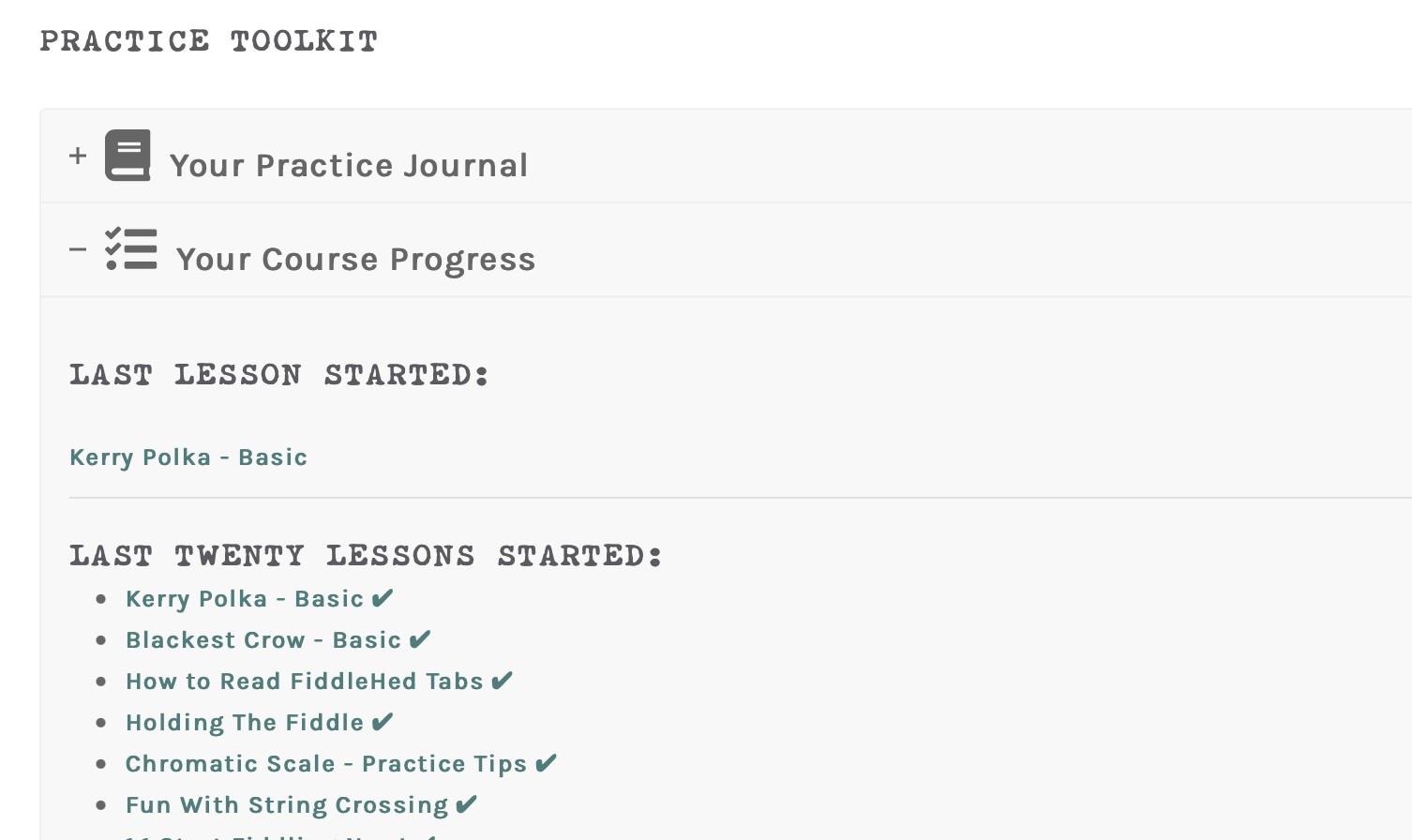
Favorites
You can mark a page as a favorite. Use this to keep track of completed lessons you want to return to in the future.
Just scroll to the bottom of the page and click the Favorite button.
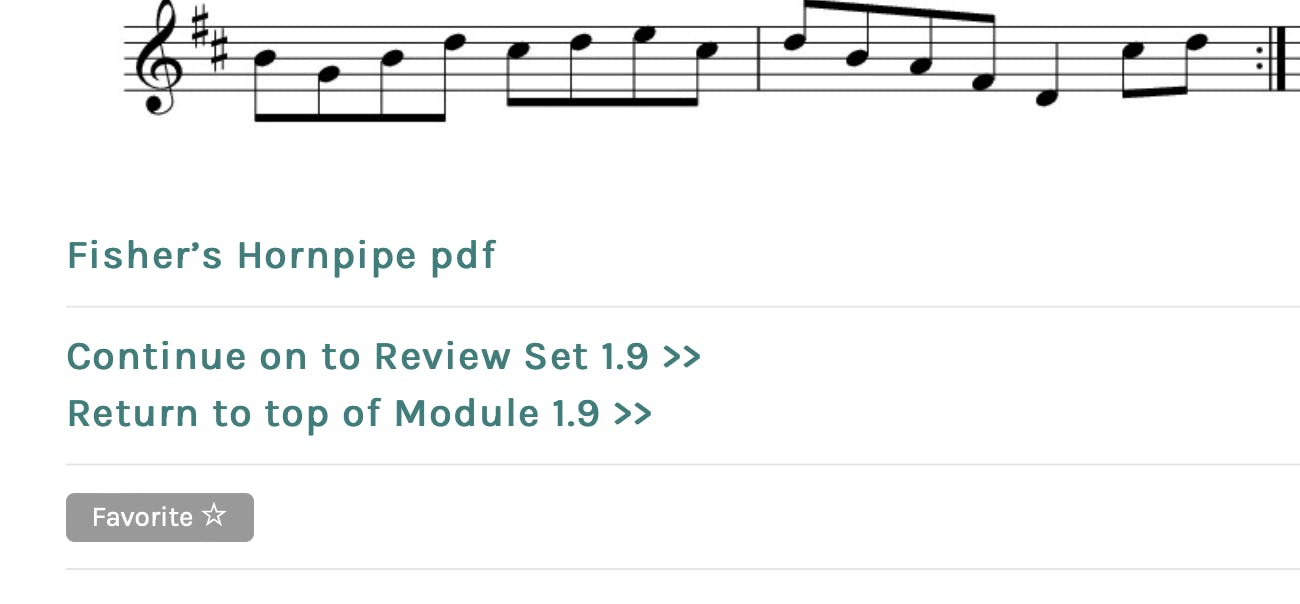
All your favorite lessons are listed under the “Favorites” tab in the “Practice Toolkit” at the very bottom of the page.

If you pause/cancel your subscription, rest assured, your course progress and saved items will remain on your account for continued use.
Finding Lessons
Five Ways To Find Lessons
- Main Search Bar
- TuneFinder
- Tune Index
- Course Module Pages
- Core Lesson Index
I’ll talk about each method below.
Main Search Bar
You can use the search bar at the upper right hand corner to find ANY PAGE on the site.

Library tab
You can also search for lessons in four ways from the Library tab:

TuneFinder
The TuneFinder is an interactive database to help you find tune lessons.
You can search by title, genre, form, scale or skill level. There’s also tab and sheet music snippets as well as full tune audio.

Tune Index
In the Tune Index you’ll find tunes listed by genre and root note. It’s a good way to browse different lists of lessons.
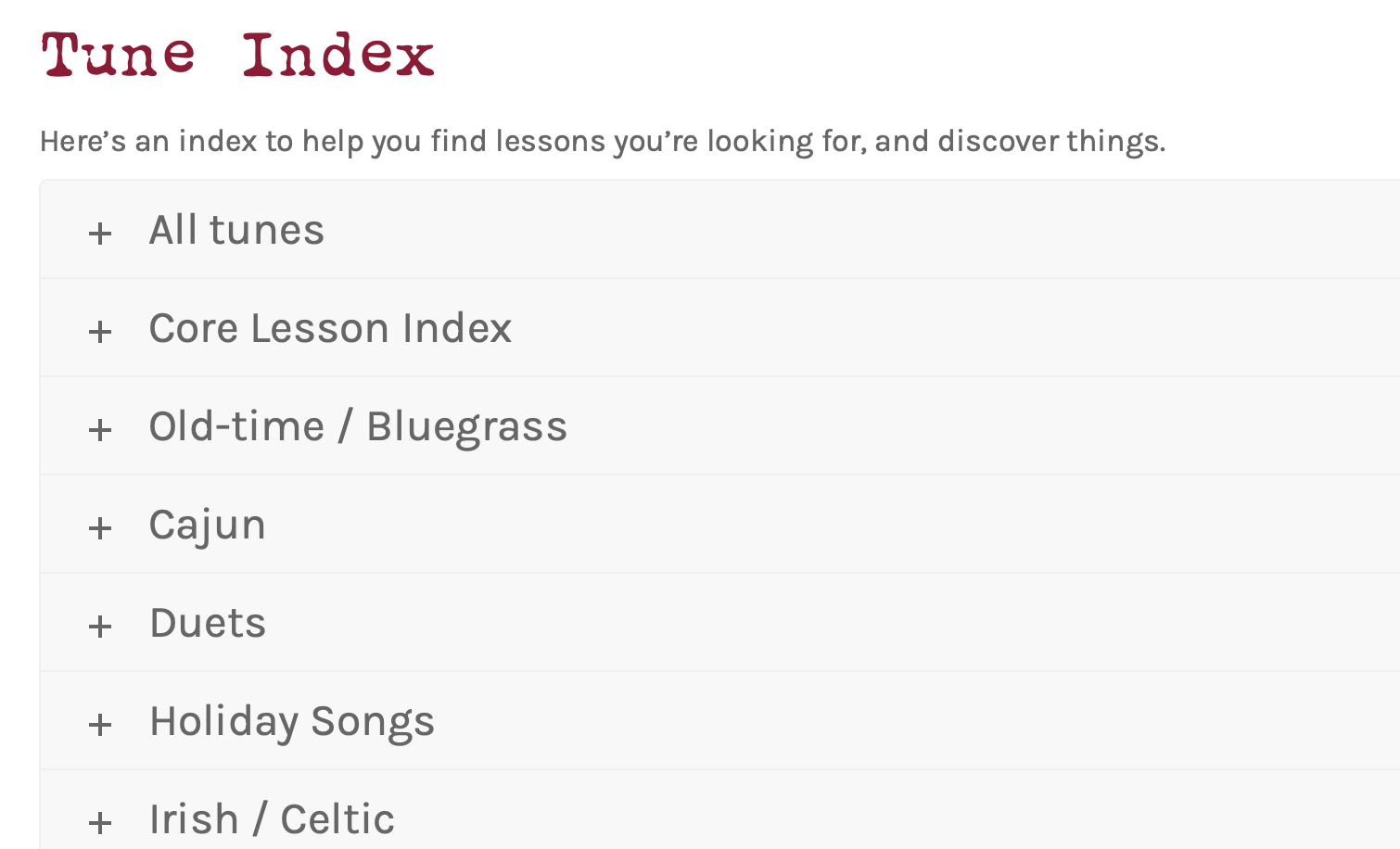
Course Modules
If you simply work through the course, you’ll encounter lessons listed in each module. Here’s an example from Module 1.6.
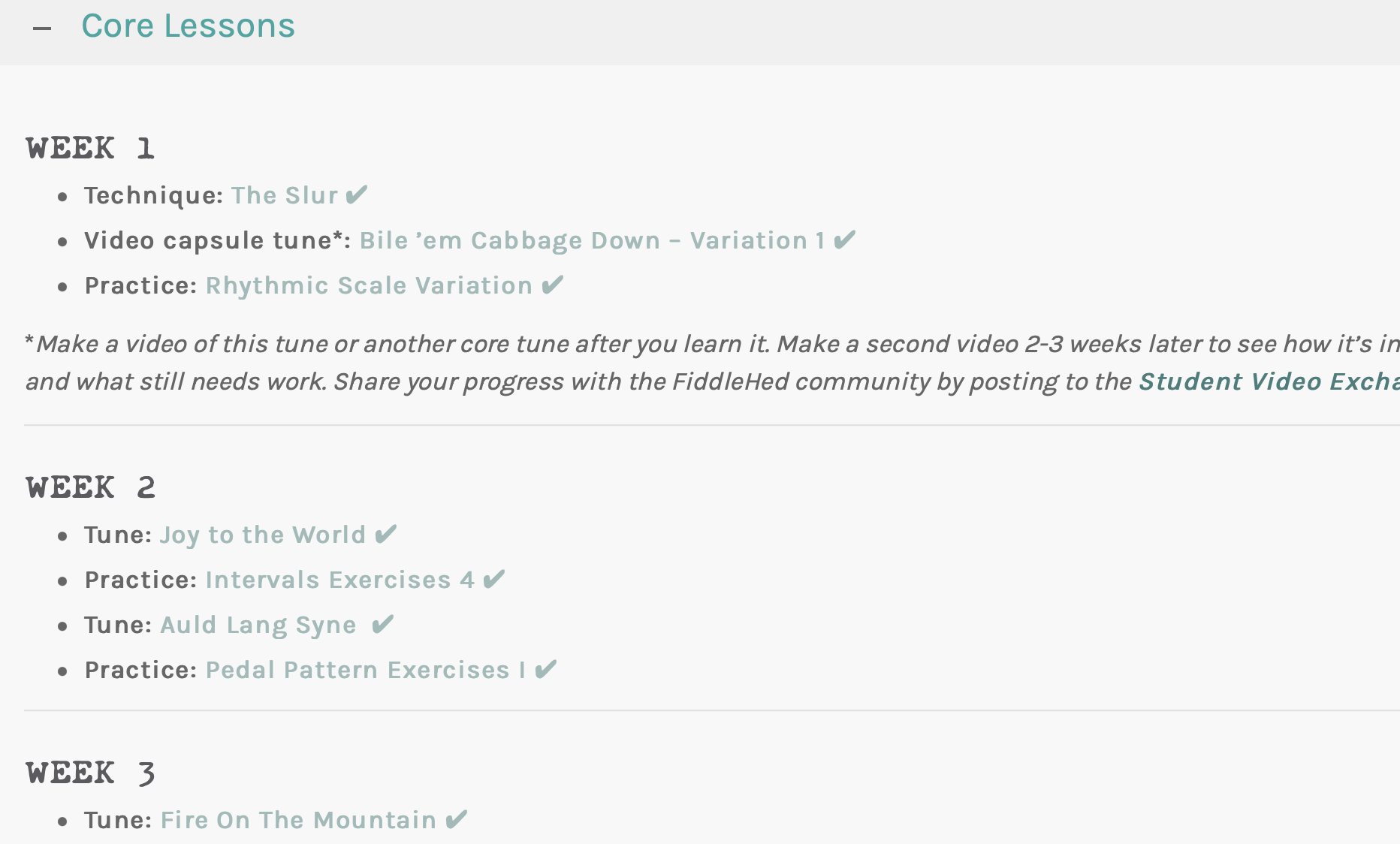
If you want to steadily build your FUNdamentals, then I recommend working through the course. Even if you’re an intermediate player, you might find that you benefit from the progressive design of the courses.
Core Lesson Index
Finally, the Core Lesson Index is a listing of all core lessons in the course. It shows you which lessons you’ve completed as well as which are not complete. It’s a handy way to see if you’ve skipped something, or if you want to review a particular lesson.
Getting Support & Answering Questions
The fastest way to answer your questions is to refer to pages under the Support tab in the top menu (on the right).

This page is a bunch of tutorials to answer questions about the various tools and navigation of the site.
This page will help you with questions about signing up, renewing, canceling, refunds, etc.
This page answers questions about fiddling, technique, music, practice, violin maintenance and more.
If you’re still stuck on something, just email us.
Essential Learning Strategies
Here’s a list of essential learning strategies taught in the FiddleHed course.
If you work through the course from the start (i.e. you’re a beginner), you’ll gradually learn these essentials.
But if you’ve already started to learn fiddle before coming to FiddleHed, then I highly recommend you take these lessons. These lessons will help you no matter where you’re at on the journey.
Drone tuning the notes on the D string
This is a method for tuning specific notes with drones (a reference tone). You can also use drones as backup when you practice: Using Drones to Create Epic Practice Sessions
Continuously play a small chunk until it sounds like music.
Call-and-response Exercises 1.3
Much of the course is based in old-school call-and-response learning. This is a fun way to train the ear, learn music and develop creativity.
Check out the full library of these lessons: Call-and-response Central
Fiddling With Deliberate Practice
Deliberate practice is a process which helps you to learn more efficiently. In a nutshell: Focus on hard parts that need work.
The essential idea is that when first learning a piece or skill, you’re not yet making music. You’re practicing and refining different motions.
Fiddling With Mental Triggers To Aid Song Memory
Here’s a great strategy to help you remember songs. Take each part and distill it down to just a few notes. This little bit acts as a “mental trigger” to help you remember the song next time.
Fiddling With Desirable Difficulty
Take a piece of music and intentionally make it more difficult. The scientific term for this is “desirable difficulty”. Find the right level of challenge by working at your edge. This helps you to learn something more deeply and to better remember what you learn.
If you write about what you practiced today, you can go further tomorrow. Use a music journal to stay motivated, organized and focused.
The mission of FiddleHed is not just to teach you tunes. I want to teach you how to learn on your own. Anything.
